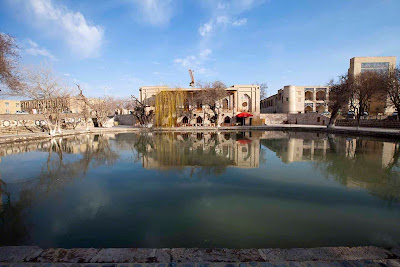When I woke up unexpectedly at three a.m. last night it suddenly dawned on me that I have not said nearly enough about the Samanids, who ruled Bukhara from c.875 to 999 a.d.
Bukhara, under Samanid rule, was the Focus of Splendour, the Shrine of Empire, the Meeting-Place of the most unique intellects of the age, the Horizon of the literary stars of the World, and the Fair of the great scholars of the Period.
So intoned historian Abu Mansur Abdu l-Malik ath-Thaalibi (961–1038), who as a young man was privileged to sit at the feet of the savants of Bukhara. One literary star of the time was Rudagi (858–c.941), who was born in a village near Samarkand on the middle Zerafshan River (some say a village near Panjakant, in current-day Tajikistan).
According to some accounts, he was blind from birth or early childhood, although this has been disputed. He flowered early as a poet and as a lyricist who may have sung his effusions and accompanied himself on the harp. He was soon noticed by the Prime Minister of Samanid Ruler Ismael (892-907), who declared that as a poet Rudagi was “peerless among the Arabs and Persians.”
According to some accounts, he was blind from birth or early childhood, although this has been disputed. He flowered early as a poet and as a lyricist who may have sung his effusions and accompanied himself on the harp. He was soon noticed by the Prime Minister of Samanid Ruler Ismael (892-907), who declared that as a poet Rudagi was “peerless among the Arabs and Persians.”
Eventually he caught the attention of Ismael’s successor, Nasr II (r.914–943) and went on to became his court poet. According to one thirteen-century historian, Rudagi was “the first to compose good poetry in Persian . . . that poet so piquant in expression, so fluent in verse, whose Diwan is famous among the Persians, and who was the leader in Persian poetry in his time beyond all his contemporaries.”
The Samanid Amir Nasr b. Ahmad, although a native of Bukhara, set up a court in Herat, the environs of which he thought more salubrious. Apparently army officers back in Bukhara, after his four year absence, wanted the Amir to return and lead them, and so they appealed to Rudagi to lure him back with his poetry. Rudagi come up with this verse in praise of Bukhara, which may well have been a ballad sung to the accompaniment of a harp.
The sands of the Oxus, toilsome though they be,
Beneath my feet were soft as silk to me.
Glad at the friends’s return, the Oxus deep
Up to our girth’s in laughing waves shall leap.
Long live Bukhara! Be thou of good cheer!
Joyous toward thee hasteth our Amir!
The moon’s the Prince, Bukhara is the sky;
O Sky, the Moon shall light thee by and by!
O Sky, the Moon shall light thee by and by!
Bukhara is the Mead, the Cypress he;
Receive at last, O Mead, thy Cypress-tree!
Upon hearing these verses, claimed the near-contemporary historian Nidhami-i-Arudi:
The Amir was so much affected that he descended from his throne, bestrode the horse of the sentinel on duty, and set off for Bukhara in such haste that they carried his riding boots after him for two parasangs [about eight miles], as far as Burana, where he put them on; neither did he draw rein anywhere until he reached Bukhara.
The historian also claims that Rudagi received for his efforts 10,000 dirhams from the army officers who wanted Nasr b. Ahmad back in Bukhara.
Rudagi’s successes as a improvisational poet, lyricist, and harper, however, earned him the scorn of traditionalists who favored a more formal style. The famous fifteenth century literary critic Dawlatshah, in his Memoirs of the Poets, scoffed at one of Rudagi’s efforts: “If anyone were to produce such a poem in the presence of kings or nobles, it would meet with the reprobation of all.” Dawlatshah appeared to be off the mark in regard to Rudagi’s popularity, however. At one point the poet owned two hundred slaves, and a hundred camels were necessary to carry his baggage when he traveled. His verses, it was said, filled a hundred volumes; he reportedly wrote 1,300,000 couplets. Almost all of his work has been lost. Unfortunately, the poet came to a bad end. He may have fell under the sway of the Ismaili Sect, considered heretical in the domains of the Samanids, and eventually fell out of favor with the court. His lament:
Who had greatness? Who had favour, of all people in the land?
I it was had favour, greatness, from the Saman scions' hand;
Khurasan's own Amir, Nasr, forty thousand dirhams gave,
And a fifth to this was added by Prince of Pure and Brave;
From his nobles, widely scattered, came a sixty thousand more;
Those the times when mine was fortune, fortune good in plenteous store.
Now the times have changed--and I, too, changed and altered must succumb,
Bring the beggar's staff here to me; time for staff and script has come!
He reportedly died in abject poverty. Perhaps in his final days he repeated one of his couplets:
Were there no wine all hearts would be a desert waste, forlorn and black,
See More Rudagi Poetry.
In 1958 the Iranian government celebrated the 1100th anniversary of Rudagi’s birth by issuing postage stamps in his name.
Iranian postage stamp honoring the 1100th birthday of Rudagi
Another Iranian postage stamp honoring the birthday of Rudagi
In 2008 his 1150th birthday was celebrated by a international seminar held in Tajikistan (the Tajikistanis go with the idea he was born near Panjakant in current day Tajikistan) and attended by Iranian panjandrum President Ahmadinejad. One can only wonder that Rudagi would have to say about Ahmadinejad. 










































